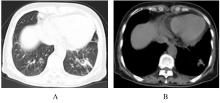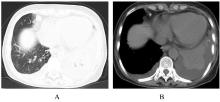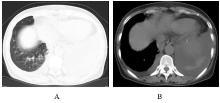| [1] |
Junjie HOU,Xuguang MI,Xiaonan LI,Xiaonan LI,Ying YANG,Xianzhuo JIANG,Ying ZHOU,Zhiqiang NI,Ningyi JIN,Yanqiu FANG.
Treatment of advanced rectal cancer with rectovaginal fistula through bevacizumab combined with FOLFIRI regimen: A case report and literature review
[J]. Journal of Jilin University(Medicine Edition), 2022, 48(3): 790-795.
|
| [2] |
Qian LI,Jiaqi ZHOU,Jingyi YUAN,Min ZHAO,Xin DI,Ke WANG.
Spindle cell carcinoma of lung: A case report and literature review
[J]. Journal of Jilin University(Medicine Edition), 2021, 47(6): 1557-1561.
|
| [3] |
Meisi REN,Yu FAN,Qingrui XUE,Tianyu WANG,Guangxiang ZANG,Hongchen SUN.
Alveolar soft part sarcoma of right buccal mucosa: A case report and literature review
[J]. Journal of Jilin University(Medicine Edition), 2021, 47(5): 1281-1286.
|
| [4] |
YANG Baoxia, LI Ping, WANG Cong, ZHANG Peng, ZHENG Baihong, XU Zhong.
Acute necrotizing encephalopathy of children with good prognosis: A case report and literature review
[J]. Journal of Jilin University(Medicine Edition), 2019, 45(06): 1449-1453.
|
| [5] |
LIU Jiaying, TIAN Chang, CONG Shan, ZHAO Min, WANG Ke.
Pulmonary sarcoidosis diagnosed by PET/CT as pulmonary lymphangitic carcinomatosis: A case report and literature review
[J]. Journal of Jilin University(Medicine Edition), 2019, 45(06): 1445-1448.
|
| [6] |
TIAN Chang, LIU Jiaying, CONG Shan, ZHAO Min, WANG Ke.
Acute gout attack with persistent medium and high fever as first manifestation: A case report and literature review
[J]. Journal of Jilin University(Medicine Edition), 2019, 45(03): 714-717.
|
| [7] |
CAO Yingkun, LIU Liping, MA Xiaoshan, YE Guowei, JIANG Yining, BAI Shiqi, LI Yunqian.
Left temporal low-grade myofibroblastic sarcoma of infant: A case report and literature review
[J]. Journal of Jilin University(Medicine Edition), 2019, 45(03): 705-708.
|
| [8] |
QIAN Chuyue, SONG Junli, LIU Naimeng, SUN Mindan.
Influence of rifampin in effectiveness of antihypertensive drugs in patients with hypertension: A case report and literature review
[J]. Journal of Jilin University(Medicine Edition), 2019, 45(02): 418-421.
|
| [9] |
LIU Jiaying, TIAN Chang, CONG Shan, ZHAO Min, WANG Ke.
Sjogren's syndrome with pulmonary bullae in both lungs as lung imaging performance: A case report and literature review
[J]. Journal of Jilin University(Medicine Edition), 2019, 45(02): 414-417.
|
| [10] |
XIN Tong, WANG Qi, CHEN Mo, LI Wei, GAO Peng.
Sjögren syndrome appeared as diffuse pulmonary cystic lesion accompanied with hemoptysis: A case report and literature review
[J]. Journal of Jilin University(Medicine Edition), 2018, 44(06): 1303-1306.
|
| [11] |
CONG Shan, MEN Lan, LIU Jiaying, TIAN Chang, WANG Ke.
True chylothorax induced by infection-caused lymphadenopathy: A case report and literature review
[J]. Journal of Jilin University Medicine Edition, 2018, 44(02): 404-407.
|
| [12] |
XIE Jinfang, LI Tianbo, GENG Wentao, LI Jing, LI Yuan, LI Xueyang, GAO Huali, ZHANG Yingli.
Bilateral maxillary fourth molars: A case report and literature review
[J]. Journal of Jilin University Medicine Edition, 2018, 44(02): 401-403.
|
| [13] |
JIAO Peng, CHEN Fei, JIN Quan, CHEN Nannan, ZHANG Li, MA Ning.
Comprehensive treatment of anterior esthetic zone in patient with loosening and falling of teeth induced by severe periodontitis: A case reeport and literature review
[J]. Journal of Jilin University Medicine Edition, 2018, 44(02): 421-424.
|
| [14] |
BAI Shiqi, WANG Yubo, GENG Ren, LI Yunqian.
Intracranial multicentric astrocytoma: A case report and literature review
[J]. Journal of Jilin University Medicine Edition, 2018, 44(02): 408-411.
|
| [15] |
JIN Kai, ZHAO Gang, WANG Yubo, ZHANG Shuai, WANG Dongdong.
Primary intracranial chondrosarcoma:A report of 2 cases and literature review
[J]. Journal of Jilin University Medicine Edition, 2017, 43(06): 1256-1259.
|
 )
)









